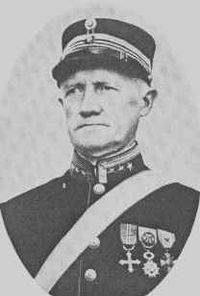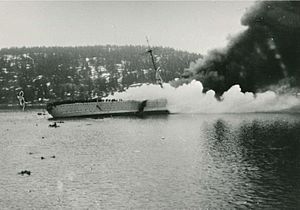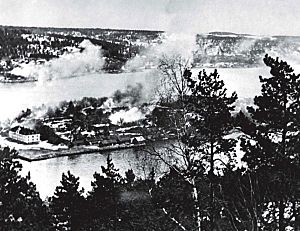Battle of Drøbak Sound facts for kids
Quick facts for kids Battle of Drøbak Sound |
|||||||
|---|---|---|---|---|---|---|---|
| Part of the Norwegian campaign of World War II | |||||||
 Blücher sinking in the Oslofjord |
|||||||
|
|||||||
| Belligerents | |||||||
| Commanders and leaders | |||||||
| Strength | |||||||
| 407 1 fortress 18 coastal guns 11 anti-aircraft guns 2 protection guns 1 torpedo battery |
2 heavy cruisers 1 light cruiser 1 torpedo boat 2 minesweepers |
||||||
| Casualties and losses | |||||||
| None | 700-850 killed and wounded 1,000 captured 1 heavy cruiser sunk 1 heavy cruiser damaged |
||||||
| 4 civilians killed 1 cutter sunk 1 cargo ship damaged |
|||||||
The Battle of Drøbak Sound happened on April 9, 1940, in a narrow part of the Oslofjord in southern Norway. This event marked the end of the "Phoney War" and the start of World War II in Western Europe.
A German fleet, led by the warship Blücher, sailed up the Oslofjord. Their goal was to invade Norway, capture the capital city of Oslo, and seize King Haakon VII and his government.
The fleet was met by Oscarsborg Fortress, an old coastal fort near Drøbak. The Germans thought this fort wasn't a threat because it was mainly used for training. However, they didn't know about the fort's secret weapon: a powerful torpedo battery. This battery would prove very effective against the German ships.
Even though the fort's weapons were old, they worked perfectly. They sank the Blücher and forced the German fleet to retreat. Losing the Blücher, which carried most of the invasion troops, delayed the German occupation. This delay gave King Haakon VII and his government enough time to escape from Oslo.
Contents
Preparing for Battle
The situation in Norway was confusing. Colonel Birger Eriksen, the 64-year-old commander of Oscarsborg Fortress, had no clear orders. He didn't know if the approaching warships were German or Allied. He knew Norway was officially neutral, but the government leaned towards supporting the British if war broke out.
Most of the soldiers at the fortress were new recruits. They had only joined the army seven days earlier, on April 2. Because of these 450 new recruits, the fortress's naval mines were not set up on April 9. Laying the mine barrier was part of the recruits' training, planned for a few days later.
The Torpedo Battery
The commander of the torpedo battery at Oscarsborg was on sick leave. So, a retired officer named Andreas Anderssen was called in to take charge. He lived nearby and had served at the torpedo battery since 1909. He knew the old weapons very well.
When the German ships started moving past the outer forts on the night of April 8, Colonel Eriksen called Anderssen. Anderssen quickly put on his old uniform and was taken by boat to the battery. He proved to be the right person to lead the fort's most dangerous weapon. The battery had three torpedo tunnels that could fire six torpedoes without reloading. Nine torpedoes were ready for use in total.
The Battle Begins
Colonel Eriksen was at the backup command station on South Kaholmen island. At 4:21 AM on April 9, he ordered the main guns to fire at the lead ship. When questioned, Eriksen famously replied, "Either I will be decorated or I will be court martialled. Fire!"
Two shots from the 28 cm guns, named Moses and Aron, hit the German cruiser Blücher from about 1,800 meters away. These guns were loaded with powerful 255 kg explosive shells. Firing them without warning shots went against Norway's pre-war rules. However, Eriksen believed he had the right to fire. The German ships had already ignored warning shots from other forts further down the fjord.

The first shell hit Blücher near the back, starting a large fire in the middle of the ship. The second shell hit a front gun turret, causing more fires and throwing parts of the ship into the water. The main guns could only fire these two shots because they were slow to reload. Only one crew of trained artillerymen was available. Cooks and other non-combat soldiers had to help man the guns. There was no time to fire the third gun, Josva, which was loaded but had no crew.
The two 28 cm shells caused huge damage because the first one exploded inside a storage area. This area held oil, smoke dispensers, bombs, and depth charges. The explosion blew out walls, and the burning oil created an intense fire. The second shell also knocked out the electricity for the ship's main guns, making them useless.
Other Batteries Join In
While Blücher burned, other Norwegian coastal batteries also fired. These included small 57 mm guns at Husvik and three 15 cm guns at Kopås Battery. The larger guns caused more damage to Blücher. The smaller 57 mm guns targeted the ship's upper parts and anti-aircraft weapons. They helped stop the fire from Blücher's light guns as it sailed past.
The Husvik battery had to be left when Blücher fired its light anti-aircraft guns directly at it. Even though the main building caught fire, no Norwegians were hurt. In total, thirteen 15 cm shells and about thirty 57 mm shells hit the German cruiser. One 15 cm shell from Kopås damaged Blücher's steering. This forced the crew to steer the ship using its engines to avoid running aground. The ship's fire-fighting system was also broken, making it harder to control the fires and help the wounded.
Identifying the Enemy
As the damaged Blücher passed the fort's guns, the Norwegian defenders heard voices from the burning ship. They heard the crew singing "Deutschland, Deutschland über alles". Only then did the Norwegians realize they were fighting Germans.
At 4:35 AM, Colonel Eriksen received a message from the Norwegian minesweeper HNoMS Otra. It confirmed that the ships were German. This message had been sent earlier but was delayed due to communication problems.
Blücher's return fire was not effective. Its light guns fired too high, and its main guns couldn't fire due to damage. The shelling lasted only five to seven minutes. When the firing stopped, there was silence on the ship.
Torpedoes Strike Blücher
After passing the fort's guns, Blücher was burning and badly damaged. But its captain still hoped to save the ship. However, at this point, Commander Anderssen at the torpedo battery had the ship in his sights. Blücher was only about 500 meters away.
The torpedoes were 40-year-old weapons made in Austria-Hungary. They had been tested over 200 times, but no one knew if they would work in battle. At about 4:30 AM, Commander Anderssen pushed the firing button. The torpedoes worked perfectly.
The first torpedo hit near Blücher's front turret, causing minor damage. Anderssen adjusted his aim for the second torpedo. This one hit Blücher in the middle, in the same area as the first 28 cm shell. This caused huge damage, breaking open many walls inside the ship. Water flooded the decks while the ship burned fiercely. The third torpedo launcher was kept ready for any other ships that might follow.
The End of Blücher
With its engines destroyed by the second torpedo, Blücher dropped anchor near the Askholmene islets. This was just north of the fort's gun range. The crew tried to fight the massive fires. Blücher's own torpedoes were fired into the land to prevent them from exploding in the uncontrolled fires.
The crew's fight ended at 5:30 AM when fires reached a storage area for 10.5 cm anti-aircraft gun ammunition. This caused a huge explosion, blowing a large hole in the ship's side. The blast also broke walls between the boiler rooms and tore open the ship's fuel tanks, starting more fires. At this point, Blücher was doomed.
At 6:22 AM, Blücher sank bow first into the Oslofjord. It rolled onto its left side, then turned upside down, and finally disappeared. After the ship sank, a lot of oil floated to the surface. This oil covered the almost two thousand sailors and soldiers struggling in the freezing water. The oil quickly caught fire, killing hundreds more Germans.
Between 650 and 800 Germans died. About 550 of the 1,400 survivors were captured by Norwegian Royal Guards. Around 1,200 survivors made it ashore near Drøbak. The guards focused on helping the many wounded. About 1,000 Germans, including General Erwin Engelbrecht and Admiral Oskar Kummetz, were moved to a nearby farm and lightly guarded. None of the prisoners were questioned. By 6:30 PM, the Norwegian soldiers left the area, abandoning the Germans. Engelbrecht and Kummetz then went to Oslo. They reached Oslo at 10:00 PM, but without most of the troops needed to occupy the capital.
Remaining Ships Retreat
By the time Blücher sank, the other German ships heading for Oslo had already turned around. They retreated back down the fjord. The commander of the heavy cruiser Lützow (formerly Deutschland) saw explosions on Blücher. Not knowing about the torpedo battery, he thought Blücher had hit mines. So, at 4:40 AM, the fleet decided to turn back. They planned to land their invasion forces out of range of Oscarsborg's guns. The plan to quickly capture Oslo was changed to a land advance up the Oslofjord.
As the German force escaped, the fortress still managed to damage Lützow. The 15 cm guns of the Kopås battery hit it three times, knocking out its front 28 cm gun turret. Kopås kept firing until the ships disappeared in the mist, about 3,000 meters away. After getting out of range, Lützow used its remaining turret to bombard the fort from 9-10 kilometers away.
During the battle, the Norwegians at Oscarsborg saw another burning ship in the distance. They thought they had sunk another German warship. For some time, they believed it was the German training ship Brummer. However, the burning ship was actually the 107-ton Norwegian cargo cutter Sørland. It had sailed into the battle by mistake, thinking it was a military exercise. German minesweepers R-18 and R-19 fired on it and set it ablaze. Sørland sank with two of its six crew members. It was the first civilian Norwegian ship lost during the invasion. The Brummer was indeed lost during the invasion, but later, on April 14, when a British submarine sank it.
Air Attacks on the Fortress
Later that day, the fortress was heavily bombed by the German Luftwaffe (air force). The fort could only fight back with two 40 mm anti-aircraft (AA) guns and seven 7.92 mm AA machine guns. Initially, four machine guns on the main battery's roof also fired, but their crews had to abandon them early.
One of the 40 mm guns broke after only 22 shots. The other kept firing until noon but had little effect. After a break, Lützow bombarded Hovedøya. Then, at 1:30 PM, the Luftwaffe bombers returned. They attacked the remaining Norwegian anti-aircraft guns, forcing the crews to hide in the nearby forest around 2:00 PM. In total, the fortress was attacked for nearly nine hours. About five hundred bombs, weighing from 50 to 200 kg, were dropped on Oscarsborg. Among the attackers were twenty-two Junkers Ju 87R "Stuka" dive bombers.
Surrender of the Fortress
Even though Oscarsborg stopped the German naval attack on Oslo, the city was captured later that day. German forces were flown into Fornebu Airport. With Oslo fallen and news of German landings south of Drøbak, Colonel Eriksen decided that fighting without enough infantry support was pointless. He agreed to a ceasefire on the evening of April 9. The fortress surrendered peacefully on the morning of April 10.
The soldiers captured from the main battery and Håøya were treated differently. They were released a week after the battle. Soldiers and non-commissioned officers from the mainland batteries were released three days after the surrender. Officers were held as prisoners of war at Fredriksten Fortress. Reserve officers were released on May 15, while full-time officers were sent to Grini prison camp and released in late May 1940.
What Happened Next
This battle was quite unusual. An old fort, manned by new recruits and retired soldiers, used 40- to 50-year-old weapons. Yet, it managed to destroy a brand new warship whose crew was still training. Oscarsborg succeeded in its mission: it stopped an invader from reaching the capital by sea.
Even though Norway was eventually captured, the delay caused by the battle was very important. On board Blücher were special troops meant to capture the King, the Norwegian government, the Parliament (Stortinget), and the national gold reserve. The delay allowed all of them to escape.
On April 9, the Stortinget met and gave the government special power to rule until the Parliament could meet again. This allowed the Norwegian government to continue fighting for Norway. They eventually evacuated to United Kingdom on June 7, and the Norwegian Army surrendered on June 10.
In the Media
The battle is shown in the 2016 movie The King's Choice.
Images for kids
-
Map of Oslofjord and the fortress of Oscarsborg
See also
- List of Norwegian military equipment of World War II
- List of German military equipment of World War II













